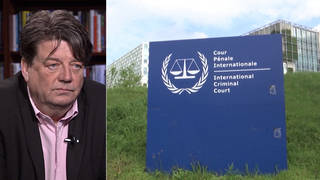
Topics
A debate on DU between Nuclear Policy Research Institute President Helen Caldicott, radiation physicist Geoffrey Sea and Dr. Thomas Fasy.
The nuclear arms watchdog group, Nuclear Policy Research Institute is warning of possible health risks to Iraqi civilians over the use of depleted uranium anti-tank shells used in Iraq. The group recently called on the Bush Administration to fully cleanup areas contaminated by DU in Iraq.
DU is considered to be the most effective anti-tank weapon ever devised. It is made from nuclear waste left over from making nuclear weapons and fuel.
The public first became aware the US military was using DU weapons during the Persian Gulf War in 1991. But it had been used as far back as the 1973 Yom Kippur war in Israel.
During the first Persian Gulf War, the U.S. used 320 tons of munitions made with depleted uranium. The Air Force fired roughly 750,000 rounds from A-10 aircraft. The Army fired over 50 of DU ammunition from Abrams tanks.
The effects of depleted uranium have been long debated. The Pentagon denies depleted uranium poses health or environmental risks. Many environmentalists say it is a radioactive carcinogen that has caused large spikes in cancer in areas like Iraq.
This weekend The Nuclear Policy Research Institute is hosting a major conference in New York on depleted uranium.
- Helen Caldicott, president of Nuclear Policy Research Institute and former President of Physicians for Social Responsibility. She is a pediatrician and has been nominated for the Nobel Peace Prize for her work on nuclear disarmament.
- Thomas Fasy, Associate Professor of Pathology, Mount Sinai School of Medicine.
- Geoffrey Sea, health physicist. He is the former executive director of the International Foundation on Radiation, Ecology and Health. From 1981-1986 he served as health and safety consultant for the Oil Chemical and Atomic Workers Union where he worked with employees at three of the nation’s depleted uranium manufacturing plants.
Link:











Media Options